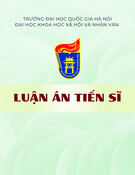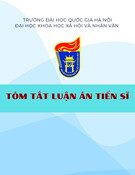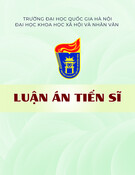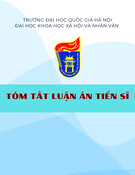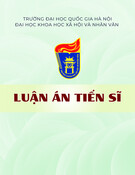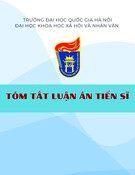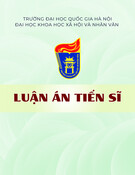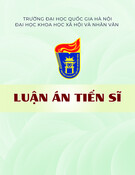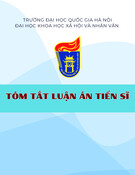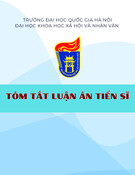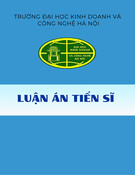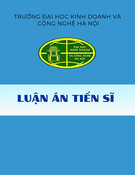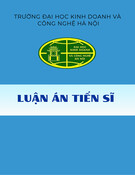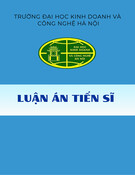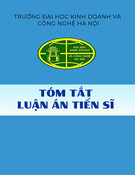VIETNAM ACADEMY OF SCIENCE AND TECHNOLOGY
MINISTRY OF EDUCATION AND TRAINING
GRADUATE UNIVERSITY OF SCIENCE AND TECHNOLOGY ----------------------------- NGUYEN PHUONG MINH
STUDYING ON THE COMPONENT OF HONEY BEE SPECIES (HYMENOPTERA: APIDAE) AND THE ABILITY TO USE SOME SPECIES AS AN INDICATOR ESTIMATING ENVIRONMENTAL POLLUTION ON AFFECTED ECOSYSTEMS IN THE NORTH OF VIETNAM
SUMMARY OF BIOLOGICAL DOCTORAL THESIS
Major subject: Entomology
62 42 01 06
Code
HA NOI – 2017
The name of postgraduate training institution: Graduate University of science and
technology, Vietnam Academy of science and Technology.
Academic supervisors
1. Assoc. Prof. Dr. Truong Xuan Lam
Reviewer 1: … Reviewer 2: … Reviewer 3: ….
2. Dr. Nguyen Thi Phuong Lien
The thesis will be defended in front of the Thesis Committee at Academy level,
at Graduate University of Science and Technology, Vietnam Academy of
Science and Technology
at … hour ..., date … month … year 201
The thesis can be found in:
- Library of Graduate University of Science and Technology
- National Library
1
INTRODUCTION
1. The imperation of the thesis
Honey bee family (Apidae) is the largest and the most diverse anout species component in Apoidea with more than 5700 described species, in which some of them had been bred for honey production. Every year, Vietnam produces nearly 20,000 tons of honey and 80-85% of total honey production is exported.
Many species of honey bee (Apidae) are important pollinators for major food crops and industrial crops on the world. However, populations of indigenous honey bee species may also be shrinked. The causes may be due to the shortage of their foods and the effects of pesticides. In addition, residues of pesticides remaining in agricultural products influence over not only human beings and domestic animals but also many species of honey bee.
Some studies have shown that composition of heavy metal and metalloids which are cumulated inside bodies of honey bee species (due to the consumption of food from the polluted environment) could be analyzed to estimate environmental pollution on the habitats where they get pollen and nectar of cultured plants.
For the above reasons, we have carried out the project “Studying on the component of honey bee species (Hymenoptera: Apidae) and the ability to use some species as an indicator estimating environmental pollution on affected ecosystems in the North of Vietnam”.
2. Scientific and practical significances of the thesis 2.1. Scientific significances The project has provided the data on species component, new recorded species, common species and species with economic value in the study area.
Furthermore, the results of the thesis have also provided data on contents of heavy metals and metalloids inside bodies, intestines, honey and beeswax of the honey bee species (Apis cerana indiaca Fabricius), based on those it is pointed out that this species can be used as a biological indicators to estimate environmental pollution.
The thesis will also provide scientific basics for proposing directions and specific solutions for the sustainable using, exploring and conserving of indigenous honey bee species in the mountain area of the study region, serving the socio-economic development of local people.
2.2. Practical significances Providing new and update information about the component, diversity and distribution of honey bee species belonging to the family Apidae in the habitats of influenced ecosystems in the Northern part of Vietnam; contributing importantly into studying on geobiology of honey bee species in the Southeast Asia in particular and on the world in general. Basing on the thesis data, it is allowed to choose Apis cerena Fabricius to be biological indicator estimating heavy metal pollution in the environment of study area.
2
3. Targets and contents of the thesis 3.1. The targets of the thesis Studying species component, distribution of honey bee species belonging to the family of Apidae, analyzing the ecological relations and determining for using some honey bee species as an indicator of environmental pollution on the affected ecosystems (farm ecosystems, perennial garden ecosystems, cultivated forest ecosystems and evergreen forest ecosystems) in some provinces in the Northern Vietnam, contributing to the conservation of honey bee species and producing high- quality honey products for the economic development of local people.
3.2. Research contents 1) Investigation of component and distribution of honey bee species of the family Apidae in some provinces in Northern Vietnam. 2) Describing of morphological characteristics of the new recorded species for the fauna of honey bee of Vietnam. 3) Studying on the possibility of using some honey bee species to estimate environmental pollution in investigated sites.
4) Determining the ecological relationship of some Apidae honey bee species in habitats of affected ecosystems and propose solutions to conserve, develop and sustainable use of these honey bee species. 4. Objects and sphere of studying 4.1. Studying objects Honey bee species (Hymenoptera: Apidae) Focus on subspecies Apis cerena indica Fabricius 4.2. Studying sphere Studying on the species component, species diversity and the distribution of honey bee species belonging to the family Apidae in some northern provinces of Vietnam. Describing morphological characteristics of new recorded honey bee species. Studying on the possibility for using honey bee species as a biological indicator to estimate environmental pollution and determining the ecological relationship of some Apidae honey bee species and some habitats in order to conserve, develop and use sustainably these species of honey bee.
5. New scientific contributions of the thesis + For the first time, the list of species component and the distribution of honey bee species belonging to the family of Apidae (Hymenoptera) in the Northern Vietnam has been systematized. + 10 species are new recorded for the fauna of Vietnam honey bees and 17 new species for the fauna of Northern Vietnam honey bees.
+ For the first time, data on the content of 10 heavy metals and metalloids inside bodies, intestines, honey and beeswax of the domestic honey bee species (Apis cerena indica Fabr.) have been provided and suggestion to choose this species as a biological indicator to estimate heavy metal pollution in environment of some northern provinces of Vietnam.
3
6. The structure of the thesis The thesis includes 146 pages in A4 form with: Introduction (8 pages); Chapter 1 – Scientific basics and overviews (31 pages); Chapter 2 – Materials and methods (13 pages); Chapter 3 – Results and discussions (78 pages); Conclusion and proposal (2 pages). The thesis consulted 112 references with 27 Vietnamese conferences, 83 English references and 2 internet site. Besides, the thesis has a list of publications and the companied appendix.
Chapter I SCIENTIFIC BASICS AND OVERVIEWS
1.1. Scientific basics In Vietnam, honey bees play a very important role in life. Valuable products from honey bees include: honey, beeswax, pollen... Besides, they also play role in pollinating many plant species, helping to disperse plant pollen, participate in biological indicators. There have not been many studies on the species component of honey bees of Vietnam and they have been conducted since 2008 (Le Xuan Hue, 2008, 2010; Khuat et al., 2012).
Foods of honey bees belonging to the family Apidae are pollens. The composition of the food is accumulated in different parts of honey bee species such as: lead (Pb) which is accumulated in excrement (Goloskov & Pimenov, 1972), copper, iron and zinc are also found in excrement but at low concentrations, while iron is found at high concentrations in specialized cells in the abdomen, copper and zinc are deposited in the muscles of the thorax (Hsu Yuan and Chia Welli, 1993). Therefore, using honey bee species as an indicator for environment has been carried out by many scientists in the world. However, in Vietnam, these problems have not been researched.
1.2. Overviews 1.2.1. The studies in the world 1.2.1.1. Studies on species component and distribution of Apidae honey bee species Studies on species component of the family Apidae on the world were conducted quite early. In 1897, Bigham recorded 278 species of honey bees belonging to 29 genera in India. Lieftinck (1944) recorded 9 species belonging to genus Anthophora in Malaysia, among them, 7 species were new for science and provided identification keys this genus. Studies on genus Thyreus in USA brought out identification key to each sub-genus, including sub-genera Xeromelecta, Melecta, Melectomimus, Meleciomorpha and recorded a new sub-genus Nesomelecta (Michener, 1948).
Identification key for species, illustrated images for classifying characteristics of genus Amegilla were provided (Lieftinck, 1956). Studies on genus Protomelissa were published by Bigham (1897), Cockerell (1911), Cockerell (1929), Cockerell (1926), Lieftinck (1944), Lieftinck (1944).
Studies of Shiokawa and Hirashima (1982) recorded 3 species of sub-genus Ceratinidia belonging to genus Ceratina in Eastern Asia and described 2 new species Ceratina takasagona and Ceratina maai.
In 2010, a new species Xylocopa atamisquensis was discovered in Argentina. (Lucia and Abrahamovich, 2010). Warrit et al. (2012) recorded 9 species belonging to sub-genus Ceratinidia in Thailand, among them 1 more new species Ceratina
4
chiangmaiensis was discovered and identification key for each genus were also provided.
According to the list of honey bee species counted up by two scientists Ascher and Pickring, genus Ceratina currently has 366 species distributing all over the world; genus Amegilla includes 247 species belonging to 12 sub-genera, distributing all over the world (according to Ascher and Pickering, 2016). 1.2.1.2. Studies on the possibility for using honey bee species as biological indicators of environment
Studies of Conti and Botre (2001) on using products of Apis mellifera (honey, pollen and beeswax) in Roma (Italy) were conducted through identifying contents of heavy metals such as Cd, Cr and Pd in order to estimate environmental pollution in this city. Another study on using bodies of Apis mellifera to watch over environmental pollution in Italy determined 250 individuals of honey bees died per week at an investigated site because of using pollen and nectar from pesticide polluted plants (Porrini et al., 2003).
Furthermore, there were some research results on this topic of Ghini et al. (2004) , Madras (2005), Chauzat et al. (2006), Chauzat and Faucon (2007), Popescu et al. (2010), Zhelyazkova (2012), Ruschioni et al., (2013), Naccari et al., (2014) and Moniruzzaman et al., (2014). 1.2.1.3. Studies on ecological relationship and conservation of Apidae honey bee species
Studies on this domain include publications of Vivian and Butz (1997), Parker et al., 2010), Becher et al., (2010), Radloff, 2011), Radloff, (2011), Shaara (2014), Loren et al. (2016) and Juliano Nogueira (2014).
Worker bees occupied a large proportion in bee colonies should be the main objects in the analysis and study of morphology and biological norms of honey bee (Ruttner, 1988). Feculity of queen bees is a very important indicator to estimate developing capacity of bee colonies as well as the quality of bee breeds (according to Shaara, 2014).
1.2.2. The studies in Vietnam 1.2.2.1. Studies on species component and distribution of Apidae honey bee species
+ Studies on species component In Vietnam, studies on species component and distribution of Apidae honey bee species have not been paid much attention. Up to now, there have been only 3 studies on the fauna of Apidae honey bee species in Vietnam. Le Xuan Hue (2008) counted up 41 species belonging to 11 genera of Apidae which were recorded, among them 25 species belonging to 8 genera recorded in Northern Vietnam. In 2010, one species of genus Bombus was described as a new species for science which based on the specimen of Vietnam (Le Xuan Hue, 2010).
Recently, 35 species belonging to 9 genera have been recorded for the fauna of Apidae honey bee species in the North and Central of Vietnam (Khuat Dang Long et al., 2012), among them 32 species belonging to 9 genera have been counted up in Northern.
5
+ Studying on honey bees bred to get honey and their distribution In Vietnam, for many years studies on honey bees have focused on species of honey bees breeding for nectar. Phung Huu Chinh and Pham Thi Huyen (2004) divided breeding honey bees species into: dwarf honey bee with 2 species (red dwarf honey bee Apis florea, black dwarf honey bee Apis andreniformis), giant honey bee Apis dorsata, Himalayan giant honey bee Apis laboriosa, domestic honey bee Apis cerana, exotic honey bee Apis mellifera. In Vietnam there are 4 main species of honey bee including European honey bee (exotic honey bee) Apis mellifera, domestic honey bee (Asiatic honey bee) Apis cerana, giant honey bee Apis dorsata and drwarf honey bee Apis florea.
According to Nguyen Van Niem (2014), in Vietnam, domestic honey bee Apis cerana includes two sub-species: A. cerana indica Fabricius, 1798 and A. cerana cerana Fabricius, 1793. Some studies of Pham Hong Thai (2008) showed that in Ly Son island (Quang Ngai), Phu Quy island (Binh Thuan) and Ca Mau peninsula domestic honey bees have not been discovered. 1.2.2.2. Studies on the possibility for using honey bee species as biological indicators of environment
In Vietnam, the possibility for using honey bees as biological indicator in order to estimate environmental pollution has not been paid much attention and has been poorly studied. Up to now, there have not been any research results on contents of heavy metals and metalloid inside bee bodies, guts, beeswax and honey. The beginning studies were at standstill in the study to determine the chemical pesticides belonging to Clo group existing in longan flower honey in Hung Yen (Phung Huu Chinh and Dinh Quyet Tam, 2004, 2007) and determining polluted limits of some metals and metalloids existing in honey, including Cd, Pb, Hg and As (Vietnam Food Administration, 2011) 1.2.2.3. Studies on ecological relationship and conservation of Apidae honey bee species
Studies on ecological relationships and conservation of Apidae honey bee species only concentrated on honey bee species breeding for nectar such as: domestic honey bees Apis cerana, Exotic honey bees Apis mellifera, red dwarf honey bee Apis florea, giant honey bee Apis dorsata (Ha Thi Hue et al., 2010). Honey bees are social insects, bee colonies is an integrated biological unit with three closely connected kinds of bees including queen bee, male bees and worker bees (Crane E., 1990; Le Quang Trung and Nguyen Tuong Van, 2012). According to Nguyen Duy Hoan, 2002 and Nguyen Duy Hoan et al., 2008 provided data on ecological forms under the influence of different surrounding factors and characteristics adapting to different living conditions of sub-species of domestic honey bees A.cerana and exotic honey bee A.mellifera.
Studies on structures of bee colonies, biological characteristics, techniques to catch forest bees in order to breed, techniques creating queen bee, dividing colonies of domestic species of honey bees Apis cerana, exotic Apis mellifera, red dwarf
6
honey bees Apis florea, giant honey bees Apis dorsata were also carried out (Phung Huu Chinh and Pham Thi Huyen, 2004).
1.2.2.4. Some remarks on studying Apidae honey bee species Up to now, in Vietnam 41 species of honey bees belonging to the family Apidae, 11 genera among them 35 species belonging to 9 genera have been recorded in the North and Central of Vietnam.
Other studies only concentrated on species of honey bee breeding for nectar such as: domestic honey bees Apis cerana, exotic honey bee Apis mellifera, red dwarf honey bee Apis florea, giant honey bee Apis dorsata. Research results on the possiblity for using honey bee as biological indicator in order to estimate environmental pollution has not been paid much attention and has been poorly studied.
Chapter 2 LOCATION, TIME AND METHODS OF STUDYING
2.1. Location and time of studying
Carrying on investigation to collect specimens in some affected ecosystems in 18 provinces in Northern Vietnam such as: Hanoi (The middle field of the Red river, Long Bien, Truc Khe, Lang Ha, Ba Vi National Park, Hoai Duc), Phu Tho (Dong Thinh, Yen Lap), Bac Ninh (Tu Son, Tien Du, Que Vo), Hoa Binh (Yen Thuy, Mai Chau, Da Bac), Yen Bai (Yen Binh, Tan Phuong, Viet Hong), Son La (Moc Chau, Muong Lum, Yen Chau, Co Ma, Thuan Chau), Lai Chau (Muong Te, Sin Ho), Dien Bien (Tua Chua, Quang Lam), Lao Cai (near Thac Bac, Hoang Lien Son National Park, Sapa, Lao Cai), Vinh Phuc (Tam Dao National Park), Ha Giang (Quan Ba, Dong Van), Cao Bang (Phia Oac, Nguyen Binh) Tuyen Quang (Nui Dum, Na Hang), Bac Kan (Lang Ngam, Ngan Son, Kim Hy, Na Ri), Thai Nguyen (Phu Luong), Lang Son (Mau Son, Huu Lung), Bac Giang (Khe Ro, Son Dong), Quang Ninh (Dong Trieu, Ba che, Tien Yen).
Experimental stidies, data processing have been carried out in the Department of Entomological Ecology, Institute of Ecology and Biological Resources and the Laboratory of Chemistry Analyzing, Institute of Military Environmental Chemistry. The thesis has been studied from 2014 to 2017.
2.2. Materials of studying Tools and equipments for investigation and experiments on the laboratory include:
Insect nets, glass tubes, glass tube holder, big trays to contain specimens, petri and triangle, abrasive pack bottles, plastic vials to contain specimens, killing insect vials (with toxin killing insects Ethyl acetate, Naphthalene…), cotton pads to keep specimens, vials to preserve specimens, pins, scissors, brushes, dissecting needles, different sized net cages, microscope Olympus 52x7, two eyed magnifier, automatic thermo-hygrometer incubator Sanyo and Wise cuber, heating apparatus, lamps and refrigerator, cotton netting, rice paper, absorbed cotton and disabsorbed cotton, notebook to record investigated and experimental data.
7
2.3. Methods of studying 2.3.1. Methods of investigating species component, distribution and describing morphological characteristics of new recorded species
2.3.1.1. Investigating and collecting specimens in the field We used the common methods of investigating insects, including : method of investigating and discovering insects, process and techniques to collect, process and preserve insects, basically methods of investigating insects, methods of Grootaert et al.(2010) including: lines survey, habitats survey and collecting methods. 2.3.1.2. Preservation, making insect sample and classification + Preservation and making insect samples: Preservation and making insect sample with cotton pads, 70° alcohol, 90° alcohol for DNA studies. + Morphological classification: Based on the documents of Michener (2005, 2007), He (2004).
+ Molecular biological classification: DNA samples after being purred and amplified, were sent to read at 1st BASE company (Malaysia). The DNA sequence were analyzed and processed with Bioedit software.
2.3.1.3. Describing some morphological characteristics of new recorded species Based on the morphological characteristics of head, thorax, scutellum, abdomen and wings. 2.3.2. Methods of studying the possibility for using some honey bee species as biological indicator
Selecting indicator species according to Chauzat et al. (2006) and Ghini et al. (2004) 2.3.2.1. Methods of community investigating and estimating potential of using Interviewing directly local people for gathering information. 2.3.2.2. Examining contents of heavy metal on the bee’s bodies and honey products
Inductively Coupled Plasma Emission Mass Spectrometry (ICP-MS) (EPA, 2007), Atomic absorption spectrophotometry, Analytical methods ICP-MS (TCVN 7602:2007, TCVN 7603:2007, TCVN 7604:2007; high performance liquid chromatography (HPLC), gas chromatography mass spectrometry GCMS 2.3.3. Methods of studying ecological relationship of honey bees species with different habitats Groups of habitats for studying ecological relationship include:
(1) Evergreen forest associated with the ecosystem of natural forest (SC1) (2) Cultivated forest associated with the ecosystem of cultivated forest (SC2) (3) Perennial garden associated with the ecosystem of perennial garden (SC3) (4) Annual crops (rice, corn, bean, peanut, sugarcane, jute, vegetables...) associated with the ecosystem of the field (SC4)
Using methods to collect and catch insects and analyze data as in section 2.3.1 2.3.4. Methods of processing data and calculating formulas
The collected data were processed, analyzed and calculated on the computer according to mathematical methods applied in biology with the level of probability
8
P<0.05 and some biological statistics software such as: SPSS 9.0 and RESTART 4.0 in Windows 2000.
Chapter 3 RESEARCH RESULTS AND DISCUSSION
3.1. Species component and distribution of Apidae honey bee species in some provinces in Northern Vietnam 3.1.1. Species component and distribution of Apidae honey bee species at investigated sites
In habitats surveyed in 18 province of Northern Vietnam, 60 species of honey bees belonging to 2 sub-families (Apinae and Xylocopinae) and 7 genera belonging to sub-family Apidae were recorded.
10 species were new recorded for the fauna of honey bee in Vietnam, including: Thyreus abdominalis rotratus, Thyreus ceylonicus lilanius, Thyreus decorus, Thyreus centrimacula, Thyreus regalis, Elaphropoda khasiana, Ceratina lieftinck, Ceratina collusor, Ceratina humilor, Ceratina sutepensis. In the North, together with above mentioned 10 species research results recorded more 7 new species for the fauna of honey bee, including: Amegilla himalajensis, Ceratina smaragdula, Ceratina simillima, Ceratina unimaculata, Xylocopa aestuans, Xylocopa dejeanii, Xylocopa ruficornis). Especially, the species Thyreus regalis was recorded in Me Linh, Vinh Phuc province and this was an important information suplementing data on the distribution of this species on the distribution world map.
The structure of species component following genera includes: genus Ceratina with the most number of species - 17 species, genus Xylocopa with 11 species, genus Thyreus with 9 species, genus Bombus with 7 species, genus Amegilla with 6 species, genus Apis with 5 species and genus Elaphropoda with 5 species. However, the highest catch rate (%) belonged to genus Apis (35,12%) and the lowest catch rate belonged to genus Elaphropoda (0,04%) (Figure 3.1).
Figure 3.1. Structure of species component of Apidae in the North Vietnam
9
Figure 3.2. The catch rate (%) of Apidae honey bee species in Northern provinces of Vietnam
Investigating of the distribution and catch rate of honey bee species in 20 Northern provinces showed that: Apis cerana had the largest distribution and appeared in 16/20 investigated provinces, the next were exotic honey bee Apis mellifera, giant honey bee Apis dorsata and bumblebee Bombus sp. distributed in 8/20 investigated provinces, dwarf honey bee Apis florea distributed in 7/20 investigated provinces. The rest species distributed in 1-3 investigated provinces. (Figure 3.2)
3.1.2. Morphological characteristics of new recorded species in Vietnam 3.1.2.1. Morphological characteristics of Ceratina collusor Cockerell, 1919 Female
Figure 3.3. Morphological characteristics of Ceratina collusor
A. Head B. Coxa of foreleg C. Space between simple and compound eye D. Thorax, dorsal view E. Prothorax F. Metanotum G. Abdomen, dorsal view H. Body 3.1.2.2. Morphological characteristics of Ceratina humilor Cockerell, 1916 Female
10
Figure 3.4. Morphological characteristics of Ceratina humilor
A. Head, front view B. Labrum C. Prothorax D. Head and thorax, dorsal view E. Metanotum F. Abdomen, dorsal view G. Body 3.1.2.3. Morphological characteristics of Ceratina sutepensis Cockerell, 1929 Female
Figure 3.5. Morphological characteristics of Ceratina sutepensis
D. Space between simple and compound eye A. Head, front view E. Abdomen, dorsal view B. Head, lateral view C. Abdomen, dorsal view F. Body 3.1.2.4. Morphological characteristics of Ceratina lieftinck van der Vecht, 1952 Female
Figure 3.6. Morphological characteristics of Ceratina lieftinck
11
D. Space between simple and compound eye F. Body A. Head, front view B. Head, lateral view C. Abdomen, dorsal view 3.1.2.5. Morphological characteristics of Elaphropoda khasiana (Schulz, 1906) Female
Figure 3.7. Morphological characteristics of Elaphropoda khasiana
D. Trochanter of hindleg E. Abdomen, dorsal view F. Body A. Head, lateral view B. Antenna C. Wing 3.1.2.6. Morphological characteristics of Thyreus abdominalis rostratus (Friese, 1905) Male
Figure 3.8. Morphological characteristics of Thyreus abdominalis rostratus
A. Head, front view B. Metanotum C. Spiracle IV-VII, dorsal view D. Tibia of middle leg E. Abdomen, dorsal view F. Body
3.1.2.7. Morphological characteristics of Thyreus ceylonicus lilacinus (Cockrell, 1919) Female
12
Figure 3.9. Morphological characteristics of Thyreus ceylonicus lilacinus E. Thorax, dorsal view (female) F. Abdomen, lateral view (female) G. Male’s body H. Female’s body A. Head, front view (male) B. Thorax, dorsal view (male) C. Abdomen, dorsal view (male) D. Head, front view (female)
3.1.2.8. Morphological characteristics of Thyreus centrimacula (Pérez, 1905) Female
Figure 3.10. Morphological characteristics of Thyreus centrimacula A. Head, front view B. Tibia of middle leg and hindleg C. Body 3.1.2.9. Morphological characteristics of Thyreus decorus (Smith, 1852) Female
13
Figure 3.11. Morphological characteristics of Thyreus decorus
C. Tibia of hindleg, external view D. Body
A. Head, front view A. Abdomen, dorsal view 3.1.2.10. Morphological characteristics of Thyreus regalis Lieftinck, 1962 Female
Figure 3.12. Morphological characteristics of Thyreus regalis
D. Spiracle VI, underneath view E. Body A. Thorax, front view B. Thorax, dorsal view C. Metanotum 3.1.3. Molecular biological characteristics of population of domestic honey bee Apis cerana in Northern provinces, Vietnam
To evaluate the diversity of bee population studied, PCR was used to amplify the segment of cox1 mitochondrial gene with COI primers. The results showed that a specific band was the right size (Figure 3.13)
14
Figure 3.13. PCR product of Cox1 gene on agarose gel 1% Analysis of nucleotide sequences by using BioEdit ver. 7.0.9 software (Figure 3.14).
(a) Sequences of cox1 mitochondrial gene of honey bee sample in Ba Vi
(b) Sequences of cox1 mitochondrial gene of honey bee sample in Lang Son
(c) Sequences of cox1 mitochondrial gene of honey bee sample in Vinh Phuc
(d) Sequences of cox1 mitochondrial gene of honey bee sample in Dong Van
(f) Sequences of cox1 mitochondrial gene of honey bee sample in Cao Bang Figure 3.14. Sequences of cox1 mitochondrial gene of 5 domestic honey bee samples Apis cerana
The relationship between populations of domestic honey bee species was determined basing on the sequences of cox1 mitochondrial gene, the phylogenetic tree is shown in Figure 3.15: 5 populations of studied domestic honey bee make up 2 different genetic groups. Group 1: Ba Vi, Cao Bang, Vinh Phuc; Group 2: Dong Van - HaGiang, LangSon.
15
Figure 3.15. The alignment 5 results of honey bee populations studied (The colored nucleotide posiyions are the mutated spots)
Figure 3.16. Grouping of 5 populations of domestic honey bee in some Northern provinces according to the sequence cox1 mitochondrial gene
3.2. Studies on the possibility for using honey bee species as biological indicators to estimate environmental pollution in studied habitats
3.2.1. Honey bee species can be used as biological indicators in studied sites A total of 9 Apidae honey bee species which could be used as biological indicator to determine heavy metal contents and pesticide residues to assess environmental pollution for studied habitats (Table 3.3).
Table 3.3. Honey bee species can be used as biological indicators in studied sites in the North of Vietnam Studied habitats N° Latin names Distribution SC1 SC2 SC3 SC4 Catch rate (%)
1. Apis cerana Fabricius 17,97 + + + +
HG, CB, TQ, LS, VP, BK, QN, HN, TN, PT, SL, LCh, LC, TH, NA, VP 2. Apis mellifera Linnaeus LS, HN, ĐB, SL, CB, 6,07 + + + +
16
6,07 + + + + 3. Apis florea Fabricius
4,76 + + + + 4. Apis dorsata Fabricius
6,32 + + + + 5. BK, HG LS, HN, ĐB, SL, CB, BK, HG HG, TQ, HN, SL, VP, QN HG, CB, TQ, LS, BK, BG, BN, HN, SL
CB 5,58 + + 6.
CB, BK, BG, SL 2,13 + + 7.
LS, HB, LC, ĐB 2,71 + + 8.
CB, HN, LC, SL, PT 3,53 + + 9. Amegilla zonata (Linnaeus) Bombus flavescens Smith Thyreus himalayensis (Radoszkowski) Ceratina nigrolateralis Cockerell Xylocopa tenuiscapa Westwood
3.2.2. Study on heavy metal contents in Apis cerena indica products at some studied sites Study on heavy metal contents in Apis cerena products (sub-species Apis cerana indica) was conducted in studied sites at 3 provinces Hanoi, Cao Bang and Ha Giang. 3.2.2.1. Heavy metal contents in body of Apis cerana indica In Hanoi, the order of 10 heavy metals studied in body of Apis cerana was: Fe >Zn >Mn > Cu >Hg>Ni >Pb>As> Co> Cd.
The results showed that, in Hanoi 3 heavy metals Fe, Zn and Mn was high and fluctuate in content, the other elements were low in content with small amplitude (Figure 3.17).
In Cao Bang, the order of 10 heavy metals studied in body of Apis cerana indica was: Fe >Zn >Mn >Cu >Pb>Ni >Co>As >Hg >Cd. Three heavy metals 3 Fe, Zn, Mn were low in content with small amplitude, Fe was found in honey bee body with high in content that determined at Tam Kim in 2015. As and Cd were found with low in content at Minh Thanh.
Figure 3.17. Fluctuation of heavy metal content in body of Apis cerana indica at studied sites
17
In Ha Giang, the order of 10 heavy metals studied in body of Apis cerana indica was Fe >Zn >Mn >Cu >Hg >Pb >Ni >As >Cd >Co. 3 heavy metals Fe, Zn, Mn were higher in content in Cao Bang and lower in content in Hanoi (Figure 3.17)
3.2.2.2. Heavy metal content in gut of Apis cerana indica In Hanoi, the order of 10 heavy metals studied in body of Apis cerana indica was Mn >Zn >Fe >Cu >Ni >Hg >Pb >As >Cd >Co. The content of Mn, Zn, Fe were found in honey bee’s gut with big amplitude, whereas Co, As, Cd, Ni and Pb were found with smaller amplitude in content (Figure 3.18).
IN Cao Bang, the order of 10 heavy metals studied in body of Apis cerana indica was Mn> Zn >Fe >Cu >Pb >Co >Hg >Ni >Cd >As. The content of 10 studied metals in honey bee’s gut in Cao Bang was found with small amplitude.
Figure 3.18. Fluctuation of heavy metal content in gut of Apis cerana studied sites The research results in Cao Bang recorded 3 heavy metals Mn, Zn and Fe which were found gut of Apis cerana with high and small amplitude in content (Figure 3.18).
In Ha Giang, the order of 10 heavy metals studied in body of Apis cerana indica was Mn >Zn >Fe >Cu >Hg >Cd >Pb >Ni >As >Co. The content of 10 studied heavy metals was found in gut of Apis cerana with smaller amplitude than it in Cao Bang (Figure 3.18).
3.2.2.3. Heavy metal content in beeswax In Hanoi, the order of 10 heavy metals studied in body of Apis cerana indica was Fe> Zn> Cu >Ni >Mn >Pb> Hg >As >Co >Cd. The content of Fe, Zn, Cu, Ni and Mn was found in beeswax with big amplitude. The content of Co, As, Cd and Pb was found in beeswax with smaller amplitude (Figure 3.19).
In Cao Bang, the order of 10 heavy metals studied in body of Apis cerana indica was Fe >Zn >Mn >Cu >Ni >Pb >Hg >As >Co >Cd; 4 heavy metals Fe, Zn, Mn and Cu were found in beeswax of Apis cerana indica with high content and small amplitude (Figure 3.19).
18
Figure 3.19. Fluctuation of heavy metal content in beeswax of Apis cerana indica in studied sites
In Ha Giang, the content of heavy metal on average was lower than Hanoi and Cao Bang. The highest content of heavy metal was Fe, then Zn and Mn. The order of 10 heavy metals studied in body of Apis cerana indica là Fe >Zn >Mn >Cu >Pb >Ni >Hg >As >Co >Cd. The content of 10 heavy metals was found in beeswax in Ha Giang with small amplitude (except FR and Zn) (Figure 3.19).
3.2.2.4. Heavy metal content in honey In Hanoi, the highest content of heavy metal on average was Fe, then Zn, Hg, Cu and Mn. The order of 10 heavy metals studied in body of Apis cerana indica là Fe >Zn > Cu >Ni> Mn> Pb >As >Hg>Co >Cd. The content of Fe was found in honey with big amplitude, whereas Hg, Co, As, Cd and Pb were found in honey with small amplitude (Figure 3.20).
In Cao Bang, the content of heavy metals on average was lower than in Hanoi, the highest was Fe, then Hg, Mn and Zn. The order of 10 heavy metals studied in body of Apis cerana indica là Fe> Mn> Zn> Cu> Ni> Pb> As>Hg> Co> Cd. The content of 10 studied heavy metals was found in honey with small amplitude (Figure 3.20).
Figure 3.20. Fluctuation of heavy metal content in honey of Apis cerana indica in studied sites
19
In Ha Giang, the highest content of heavy metal on average was Fe then Zn and Hg. The order of 10 heavy metals studied in body of Apis cerana indica là Fe >Zn >Cu >Mn >Pb> Ni>As > Hg >Co >Cd. The content of 10 studied heavy metals was found in honey with small amplitude (Figure 3.20).
3.3. Study on ecological relationship of honey bees species with different
habitats and propos some conservation measures 3.3.1. The relationship between species component and with different types of habitats
Figure 3.21. The relationship between number of honey bee species and
catch rate of Apidae in studied habitats
The results of field survey showed that the number of honey bee species and their catch rate in 4 studied habitats were different. The results are presented in Table 3.8.
Table 3.8. The number of honey bee species and their catch rate in studied habitats Number of species Studied habitats Catch rate (%)
SC1 SC2 SC3 SC4 Number 52 36 24 22 Rate (%) 93,33 60,00 40,00 36,67 82,03 76,03 60,6 54,3 The relationship between the number of species and their catch rate belonging to Apidae in 4 studied habitats is shown in Figure 3.21.
With 60 species distributed in 4 different habitats in studied sites, there were 10 species which are recorded in all of habitat with 4 genera. Among them, genus Apis had the most number of species (4 species), including: Apis cerana, Apis mellifera, Apis dorsata and Apis florea, which were also common species with high catch rate in studied sites.
The Shannon - Weiner diversity index (H’) of each studied habitat with the number of species and the number of collected individuals was shown in Table 3.9. It showed that the Shannon - Weiner diversity index (H’) of Apidae honey bee species recorded in studied habitats was different. The highest index (H’ = 2,99) was in SC1 and the lowest index was in SC3 (H’ = 1,99), SC2 with H’ = 2,25 and SC4 with H’ = 2,29.
20
Table 3.9. The Shannon - Weiner diversity index (H’) of Apidae honey bee species recorded in 4 studied habitats
Studied habitats
N° of species
N° of individuals
The Shannon - Weiner (H’)
SC1
52
445
2,99
SC2
36
161
2,25
SC3
24
98
1,99
SC4
22
180
2,29
Evergreen forest associated with the ecosystem of natural forest Cultivated forest associated with the ecosystem of cultivated forest Perennial garden associated with the ecosystem of perennial garden Annual crops (rice, corn, bean, peanut, sugarcane, jute, vegetables...) associated with the ecosystem of the field
The similarity index of species component among habitats showed the differences in 4 studied habitats, the results was shown in Figure 3.22. The results showed that SC1 and SC2 had similarity index of nearly 40%, SC3 and SC4 had similarity index of more than 60% and the similarity index of two groups of habitats was only about 10%.
Figure 3.22. The similarity of species component collected in studied habitats 3.3.2. The relationship between the number of flower visiting of some honey bee species in perennial garden habitat and annual crop habitat
The family Apidae has two sub-families that had been recorded in both habitats (SC3 and SC4). In SC3, 24 species belonging to 7 genera were recorded. In which, 6 species with high catch rate and number of individual were observed (Figure 3.23).
Figure 3.23. Catch rate of some honey bee species in perennial garden habitat in studied sites
21
In SC3, 22 species belonging to 4 genera were recorded. In which, 6 species with high catch rate and number of individual were observed. The result was shown in Figure 3.24.
Figure 3.24. Catch rate of some honey bee species in annual crop habitat in studied sites
Nectar and pollen providing plants play an important role with honey bees because they are their main food. In Vietnam, nectar and pollen providing plants are quite abundant and widely distributed.
Figure 3.25. Visiting rate of longan flowers of some honey bee species in perennial garden habitat in Song Phuong commune, Hoai Duc, Hanoi
A survey of flower visiting rate of 6 honey bee species in longan flowers in Hoai Duc, Ha Tay (SC3) showed that: A. cerana had the highest flower visiting rate and C. compacta had the lowest flower visiting rate (Figure 3.25).
22
Figure 3.26. Visiting rate of litchi flowers of some honey bee species in perennial garden habitat in Tru Huu commune, Luc Ngan, Bac Giang
A survey of flower visiting rate of 6 honey bee species belonging to 2 genera Apis and Ceratina on litchi in Luc Ngan, Bac Giang (SC3). The result was shown in Figure 3.26.
Figure 3.27. Number of Apis cerana cought on maize in annual crop habitat in Thuan My commune, Ba Vi, Hanoi
The results of number of Apis cerana cought on winter maize crop in annual crop habitat in Thuan My commune, Ba Vi, Hanoi showed that the highest number of Apis cerana was 55 individual/25 plants at reproductive development stages (Figure 3.27). These results also showed that this domestic honey bee species plays an important role of pollination for maize, the relationship between this species and maize bring a high yielding of maize and high benefit for farmer. 3.3.3. Sustainable use of common honey bee species in natural forest habitat (SC1) and cultivated forest habitat (SC4)
There were 5 species and sub-species of honey bees that are regularly exploited in SC1 and SC2. Among them 2 sub-species and 1 species had been
23
mass rearing, they are Apis cerana cerana, Apis cerana indica and Apis mellifera. There are 2 species that are only exploited in natural forest habitat and cultivated forest habitat: Apis dorsata and Apis florea.
Table 3.11. Some over exploited Apidae honey bee species in natural habitats that needs to protect and sustainable use in studied sites
N° Exploitation areas Exploitation time Types of product Exploite d species Exploita tion forms
1. Breeding Dong Van, Ha Giang
Apis cerana cerana Fabricus Honey, larvae, hive, beeswax and pollen
2. Breeding
Apis cerana indica Fabricus Honey, larvae, hive, beeswax and pollen
3. Breeding
Apis mellifera Linnaeu s Honey, larvae, hive, beeswax and pollen
4. Getting in natural Honey, larvae and adults
5. Getting in natural Honey, larvae and adults Apis dorsata Fabriciu s Apis florea Fabriciu s Ha Giang, Cao Bang, Tuyen Quang, Bac Kan, Lang Son, Thai Nguyen, Bac Giang, Quang Ninh Ha Giang, Cao Bang, Tuyen Quang, Bac Kan, Lang Son, Thai Nguyen, Bac Giang, Quang Ninh Ha Giang, Cao Bang, Tuyen Quang, Bac Kan, Lang Son, Thai Nguyen Ha Giang, Cao Bang, Tuyen Quang, Bac Kan, Lang Sơn, Thai Nguyen Around the year (Except January, February and December) Around the year (Except January, February and December) Around the year (Except January, February and December) March, Avril, May, June and July March, Avril, May, June and July
24
CONCLUSION AND PROPOSAL Conclusions
+ In some mountainous provinces of the North, Vietnam, 60 species of Apidae, belonging to two sub-family Apinae and Xylocopinae with 7 genera had been recorded, among them the domestic species Apis cerana Fabricius, 1793 has 2 sub- species Apis cerana cerana and Apis cerana indica. 10 species are new recorded for the fauna of Vietnam honey beess and 17 new species for the fauna of Northern Vietnam honey bees. The world distribution of 10 species and especially Thyreus regalis were also added.
+ 9 species of honey bee had been identified which could be used as biological indicators for environment. Among them, 5 species had been able to determine the content of some heavy metals, metalloids inside bee’s body, pollen, beeswax and honey. Especially, sub-species Apis cerana indica and 4 remain species could be used as indicator for habitats.
+ The content of 10 elements Fe, Mn, Zn, Pb, Cu, Co, Ni, Cu, As, Cd and Hg in body, gut, beeswax and honey of Apis cerana indica in studied sites such as Ha Giang, Cao Bang and Hanoi was different, among them, 3 heavy metal Fe, Zn and Mn were found with high content and big amplitude, Hg, Pb, As and Cd were found with low content and small amplitude. At sampling sites, the pollution limit index of Hg, Pb, As and Cd in honey was below the allowable threshold and safe to use.
+ The proportion of heavy metals in body, gut and beeswax of A. cerana indica has been determined. The metals Fe, Zn, Mn, Co, Cu, Zn, Cd accumulated much more in bee’s gut than bee’s body and much more in beeswax than honey.
+ The most honey bee species was recorded in SC1 (93,33%) and the least honey bee species was recorded in SC4 (36%). The Shannon diversity index (H’) in SC1 was highest and in SC3 was lowest. SC3 and SC4 had a high species similarity and SC1 and SC2 had a low species similarity. With 24 species recorded in SC3 and 22 species recorded in SC4, the highest catch rate belonged to Apis cerana. Apis cerana was the species that had the highest rate of visit to longan and litchi flowers in SC3, the following was Apis mellifera and Apis dorsata. Apis cerana plays an important role of pollinating in maize in SC4.
Proposals + It is necessary to continue studying the role of biological indicator of subspecies Apis cerana indica to determine the content of some heavy metals or residue of pesticides to propose a limited standard of heavy metal to evaluate the quality of habitat through these honeybees.
+ Quantitative studies on the role of polinators for plants and the sustainable exploitation of Apidae in nature should be conducted. Enhance infomations on the relationship between honey bees, plants and their habitats for the sustainable development of honey bee species.

